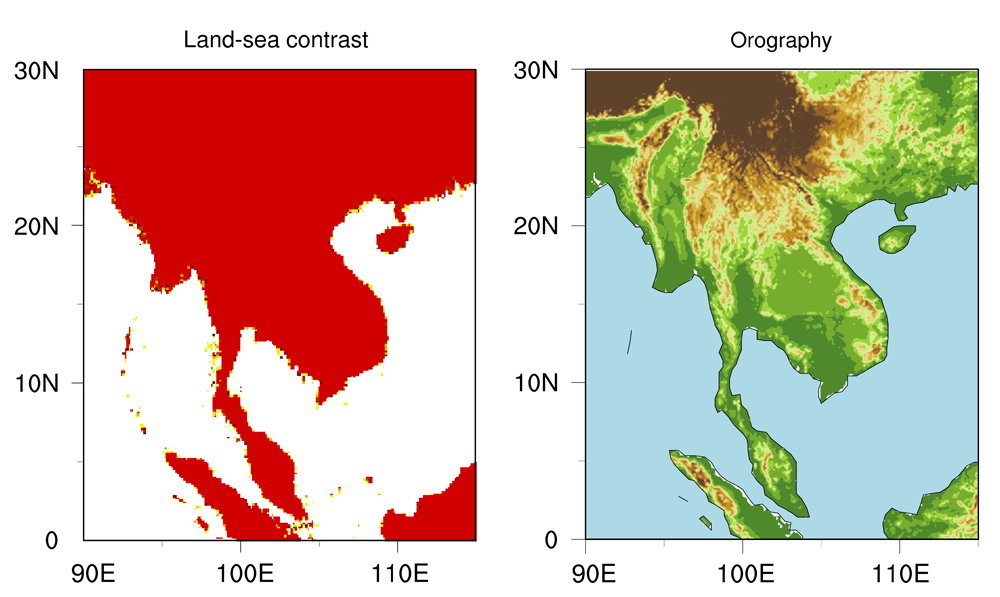中国科学院大气物理研究所大气科学和地球流体力学数值模拟国家重点实验室
State Key Laboratory of Numerical Modeling for Atmospheric Sciences and
Geophysical Fluid Dynamics (LASG)
Institute of Atmospheric Physics, Chinese Academy of Sciences
State Key Laboratory of Numerical Modeling for Atmospheric Sciences and
Geophysical Fluid Dynamics (LASG)
Institute of Atmospheric Physics, Chinese Academy of Sciences

Vol.17/No.17 April 2022
How Does Indochina Peninsula Affect Asian Summer Monsoon?
The extension of the Asian subtropical continent into the tropics, including the Indochina Peninsula (ICP), is generally considered an important agent for inducing and maintaining the Asian summer monsoon (ASM).

The land-sea contrast and orography over the Indochina Peninsula. (Image by ZHUANG Moran)
To fully understand the seasonal response of the ASM to the ICP, instead of focusing on only one factor and one summer stage, ZHUANG and her collaborators used an atmospheric general circulation model of finer resolution. Based on the model, they examined the differences in ASM's response to both the orography and land-sea contrast over the ICP between early and late summer.
They found that the orographic effect increased South Asian rainfall and reduced the rainfall over the South China Sea (SCS) and North China in early summer, but its influence on monsoonal circulation and rainfall was limited to East Asia in late summer.
The impact of the ICP's land-sea contrast was basically opposite in the two summer stages. With the presence of the ICP, SCS rainfall was enhanced but South Asian rainfall was weakened in early summer. In late summer, however, rainfall from the ICP to the northwestern Pacific was strikingly reduced, accompanied by intensified rainfall over South Asia.
The team went further to identify the relative importance of the narrow mountains and land-sea contrast of the ICP and investigate the underlying physical process behind the impact of the ICP on the ASM.
They found the orographic effect seemed to be more important in modulating the South Asian monsoon in early summer while the land-sea contrast was dominant in strengthening the SCS monsoon and suppressing the Northwest Pacific monsoon via the interaction between the induced local circulation and multi-level ASM subsystems. In late summer, the orographic effect on the ASM was much weaker compared to the land-sea contrast, which plays a critical role by shifting the subtropical high southwestwards and through the "thermal adaption" feedback mechanism.
"The orography and land-sea contrast over the ICP have profound but different impacts on the ASM. Our work has revealed different monsoon circulation and precipitation response to the topography and land-sea thermal contrast over the Asian subcontinents in two summer stages. This helps us better understand the interaction between the ICP and the ASM," said Prof. DUAN Anmin, corresponding author of the study.
Citation:
Zhuang, M., Duan, A., Lu, R., Li, P., & Yao, J. (2022). Relative impacts of the orography and land–sea contrast over the Indochina Peninsula on the Asian summer monsoon between early and late summer, Journal of Climate (published online ahead of print 2022). https://doi.org/10.1175/JCLI-D-21-0576.1
Link: https://journals.ametsoc.org/view/journals/clim/aop/JCLI-D-21-0576.1/JCLI-D-21-0576.1.xml
Contact: DUAN Anmin, amduan@mail.iap.ac.cn
Add: No.40, Huayanli, Beichen West Road, Chaoyang District, Beijing P.O. Box 9804, 100029, China
E-mail: lasg_newsletter@lasg.iap.ac.cn
Editors: Chuanyi Wang (wangcy@lasg.iap.ac.cn), Kangjun Chen(ckj@lasg.iap.ac.cn)
E-mail: lasg_newsletter@lasg.iap.ac.cn
Editors: Chuanyi Wang (wangcy@lasg.iap.ac.cn), Kangjun Chen(ckj@lasg.iap.ac.cn)